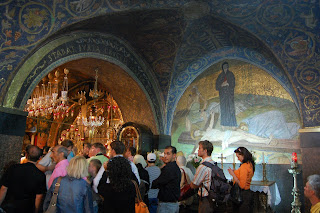In "The Cost of Discipleship," Dietrich Bonhoeffer explains that there is a two-part surrender to God: for Abraham, he gave up his homeland to start a family as a stranger in a strange land, but then was asked to give up his son; for Peter, he gave up fishing to become a member of Jesus' inner circle, but then he gave up being a disciple; for Martin Luther, he gave up the life of a worldly priest to become a cloistered monk, but then gave up the monastery. In each of these examples, the one who gave up everything to follow Christ ended up back where they started, yet at the same time, everything was different for them: Abraham kept his family, but understood his family in a new way; Peter returned to fishing, but became a fisher of people; Luther lived out his years as a priest in the world, but as a Protestant rather than a Catholic. For me, as I return to the very same life I left two weeks ago, I am pondering my two-part surrender. I gave up approaching the Bible as an historical document years ago. How can the infinite God be contained by a finite history? What I have surrendered on this pilgrimage is the idea that historicity and reality have to be the same thing. The mystery of faith that we proclaim may not be a historical fact, but it is most definitely an historical reality:








